Every racial, ethnic and cultural group on Titan has its preferred weapon types, styles and designs. These are delineated in the lists primarily for ‘flavor’ and character building. In most cases there is no great or significant difference between one type of axe and another Beyond the shape and curve of a Zamoran Falcon, their is little difference (in Game Mechanics) from a Gallennic Broad Sword. Prices may vary depending on where the character is when buying. For example, a market stall in a town in Gallenna is not likely to have many ‘foreign’ Falcons for sale, but will have a few broad swords.
There ARE exceptions….
Arrows, Bows and Crossbows…
Generally speaking, Self longbows are the bow of choice for the Gallenna Barbarian Mountain Clans and most of Eastern Solista and parts of Central Solista.
Self short bows are widely used throughout western Central and Western Solista, most of the Independent Kingdoms and the Sea Coast Barbarians of Gallenna. They are also very common throughout most of Palador
Compostie Long Bows are made and used by the Elves and, reportedly, by the bowyers of Zamora.
Composite short bows are made and used by the Yttral Nomads of Palador and, reportedly, by the bowyers of Zamora.
A detailed description of Bows, Composite Bows and Arrows can be found here.
Crossbows, originally a Dwarven invention, are found in the various forms throughout Titan (though they are almost unheard of in Zamora.)
A detailed description of Crossbows can be found here.
DM NOTE: There ARE changes in Bows, Arrows, Crossbows and Bolts from the listings in the PHB.
Axes
Probably THE single most commonly used hand weapon throughout Titan is the Axe.
It comes in an array of styles, one hand, two hand, single blade, double blade, hammer back, throwing, broad blade….. Virtually every peasant has access to some kind of axe or hatchet. It is used as a primary melee weapon, or as a short range missile weapon, by fighters from the frozen mountains of Gallenna to the steamy jungles of Katraala.
Note: Axes are most effective against Small to Man sized creatures and less effective against Large enemies.
| Name | Cost GP |
Weight GP |
Damage | |
| S – M | L | |||
| Ahrk (throwing ax) thrown | 2 | 10 | 1-6 | 1-4 |
| Used in hand | — | — | 1-6+1 | 1-4+1 |
| Chahk | 5 | 35 | 1-8 | 1-8 |
| Used two handed | — | — | 1-8+1 | 1-8+1 |
| Battle Ax/Hammer, ax side | 7 | 40 | 1-10 | 1-8 |
| Hammer | — | — | 1-4+1 | 1-4 |
| Battle Ax/Pick, ax side | 8 | 40 | 1-10 | 1-8 |
| Pick | — | — | 1-6+1 | 2-8 |
| Battle Ax, Single blade | 5 | 50 | 1-10 | 1-8 |
| Used two handed | — | — | 1-10+1 | 1-8+1 |
| Battle Ax, Double blade, two handed | 9 | 75 | 1-10+1 | 1-8+1 |
| Hand Ax/Hatchet, used in hand | 1 | 20 | 1-6+1 | 1-4+1 |
| Thrown -1 to hit | — | — | 1-6 | 1-4 |
| Woodsman (Common) Ax, two handed | 2 | 60 | 1-6+1 | 1-6+1 |
| ‘Kleaver Ax’ or ‘Goblin Ax’ | 7 | 125 | 1-12 | 3-12 |
| Name | Fire Rate | Range | ||
| Short | Medium | Long | ||
| Ahrk | 1 | 1.5 | 2.5 | 3.5 |
| Hand ax/Hatchet | 1 | 1 | 2 | 3 |
Gallenic Axes
Ahrk
The throwing axe of the Barbarians. Most Chegga (Warriors) carry at least two of these short hafted, single blade, throwing axes and a ‘Havahk’ fighting spear (see below.) The Ahrk are hurled at an enemy prior to closing to melee. Sometimes one is held back as an emergency back up or off hand weapon. Ahrks have a slightly better throwing range then ordinary hatchets and hand axes.
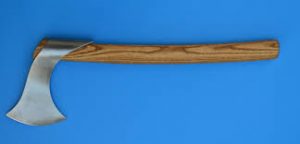
Arhk
Chahk
The ‘Chahk’ is essentially a longer hafted version of an Ahrk. The head is often a bit bigger as well. It is NOT a throwing weapon, but is a one or two handed melee combat weapon. Wealthier Chegga will have one of these slung across their back as a secondary weapon along side their Havahk.
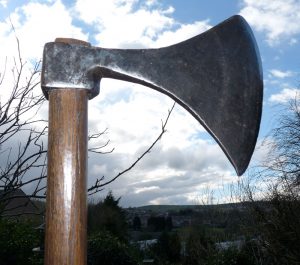
Chahk
Outside of Gallenna, both of these axes are most common in Eastern Solista and amongst the Rhun.
Dwarven Axes
Dwarven ax styles are noted for being dual purpose weapons. Typically one face is an ax while the other is a hammer or pick. This is a reflection of the fact that Dwarven miners routinely use these weapon/tools and are always vigilant to attack in the underground areas where they work and live. Of course, other races make ‘dual function’ axes. These dual purpose axes are always one handed weapons.
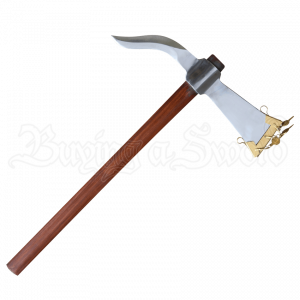
Pick/Axe
Dwarven MADE Combat axes (those made strictly for fighting) often are made from a single piece of metal. The head, haft and grip are all one piece. The grip will usually be wrapped or otherwise built up. Some human smiths also make these, but they are uncommon.
Double Bladed Axes
Sages claim that the Double Bladed Ax actually originated (as a common style) in Zamora. The Dwarves can and do make them, but it is not a common design, being exclusively a combat weapon and the Dwarves favor (for themselves anyway) multi purpose weapon/tools. Double bladed axes, due to their weight and heft, are long shafted, two handed weapons (though Ogres, Buge and those of great strength, can use them one handed.)
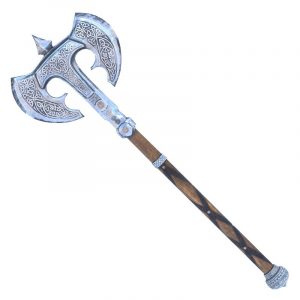
Double Bladed Ax
Hand Axe or Hatchet
Small ax commonly found in most homes. Intended for making kindling, killing chickens, cutting light brush, etc. Though not designed to be thrown, it usually can be though not well (-1 to hit.)
Woodsman or Common Ax
An ax most commonly found around a farm for felling trees and splitting logs. This is a long handled, two handed ax.
Great Ax or ‘Goblin Ax’
This two handed weapon is a particular favorite of Buge Goblins (Bug Bears) and Ogres. It requires a strength of 17 or greater to use, but there are reports of the ax cutting the head from a horse or ox with one blow.
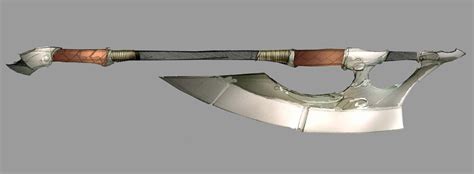
Great Ax “Goblin Ax”
Darts
The favorite weapon of the Magic User. These ARE NOT the darts thrown in tap rooms throughout Great Britain and Ireland or found in basement rec rooms. These are War Darts, more closely related to the Roman Plumbata. They are about ten inches long with a weighted point and a sharp tip. They have fletchings of feathers or thin leather or light wood. They are made to be thrown over hand and are widely used in light infantry formations in parts of Solista and Palador, where a quiver of Long Darts is attached to the inside of a soldier’s shield.
| Name | Cost | Weight GP |
Damage | |
| S – M | L | |||
| Short Dart | 5sp | 3 | 1-3 | 1-2 |
| Long Dart | 10sp | 5 | 1-4 | 1-3 |
| Name | Fire Rate | Range | ||
| Short | Medium | Long | ||
| Short Dart | 3 | 1.5 | 3 | 4.5 |
| Long Dart | 2 | 2.5 | 5 | 6 |
Short vs Long
Darts come in two lengths, short and long. Usage, in terms of proficiency, is the same. Short Darts are the ones listed in the PHB and are the MU’s friend. Long Darts are more commonly used in mass volleys. Long Darts are heavier, can go somewhat further and do more damage then the Short Dart. Short Darts are faster to deploy, giving a higher ‘rate of fire’.
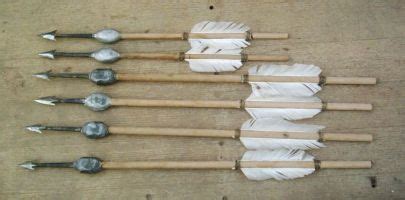
Short Darts and Long Darts
Spears
After the axe, the spear is the most widely used weapon on Titan. Ranging in length from short, sturdy, stabbing spears to longer, lighter, throwing spears, to very long lance and pikes that are used from horseback or armored formations of infantry. The Gallenna Barbarians name their fighting spears while Solistan peasants are known to improvise theirs with staves and butcher knives…

| Name | Cost | Weight GP |
Damage | |
| S – M | L | |||
| Boar Spear | 2 | 50 | 1-6 | 1-8 |
| Combat/Fighting Spear | 4 | 50 | 1-6+1 | 1-8+1 |
| Formation Spear | 3 | 80 | 1-6 | 1-12 |
| Throwing Spear | 1 | 40 | 1-6 | 1-8 |
| Javelin | 10sp | 20 | 1-6 | 1-6 |
| Lance | 6 | 100 | 1-6+1 | 2-12 |
| Name | Fire Rate | Range | ||
| Short | Medium | Long | ||
| Boar Spear | 1 | 1 | 2 | 2.5 |
| Combat/Fighting Spear | 1 | .5 | 1 | 1.5 |
| Throwing Spear | 1 | 1 | 2 | 3 |
| Javelin | 1 | 2 | 4 | 6 |
Boar Spear
Boar Spears are designed for hunting large, dangerous game (though they can be used in combat.) The principal feature of a Boar Spear is a cross bar, usually of metal but can be stout wood or bone, about 6 to 10 inches behind the base of the blade. This is designed to allow the blade to penetrate deep enough to reach the beast’s vitals, but prevent the enraged creature from forcing its way up the length of the spear shaft to get at the hunter. Boar spears are usually about six feet long. They are made and used all over Titan where
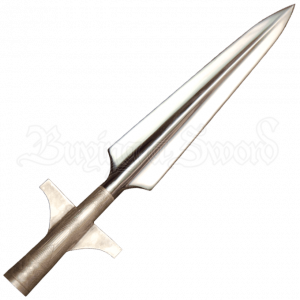
Hunting Spear Head
ever large game is found. The name may vary based on what the local Big Game threat is.
Combat Spear
Combat or ‘Fighting’ Spears are very common through out Gallenna, and also in Katraal in Palador. Most Gallenna warriors, ‘Chegga’ carry a Fighting Spear and two or three ‘Ahrk’ (throwing ax) as their primary and secondary weapons.
Fighting spears have thicker, stouter shafts then a throwing spear, longer blades and usually at least the first third of the shaft from the blade is reinforced with metal to make it able to parry without fear of breaking or being chopped through. Lengths vary from 4.5′ to 6.5′ With the longer ones common in Katraal. Length reflects the combat technique of the fighter. Shorter spears are used one handed in conjunction with a shield in stabbing and slashing attacks. Longer ones are used two handed with a buckler sized shield (if any.)
Fighting spears are not balanced for throwing and a warrior would no more throw it at an enemy then they would a sword!
Gallenic Fighting Spears, called ‘Havahk’ and range from 4′ to 5′ in length and are prized by the warriors who name them and have the blades engraved with runes that recall noted kills.
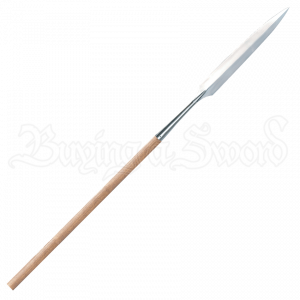
Fighting Spear
Formation Spear
These are, in proper nomenclature, more of a pike then a spear. They are listed here because pole arms in general, other then the long ‘Formation’ spear or pike, are not that common in Solista or Palador. The nations of south, Central Solista do make use of these long spears in phalanx type infantry formations employing ‘shield wall’ tactics. Equipped with large shields, breast plates and helms, with a short sword,or axe as a secondary, the spear troops are common in the populated areas.
The Formation spear is a thrusting only weapon that is anywhere from 9′ to 12′ in length, with a very pointy, twelve inch blade and reinforcing metal extending back several feet to keep an enemy from hacking off the tip..
Throwing Spear & Javelin
Throwing spears, and their lighter weight cousins the javelin, are a common missile weapon deployed just before opposing forces come into direct contact.
Both throwing spears and javelins have light weight shafts with pointed tips, that are balanced for throwing. Javelins, being somewhat shorter and lighter then the spear, can be thrown further but does less damage. It is best suited for use against lightly armored opponents and javelin troops, carrying as many as six javelins, usually work in close support of the Shield Wall on the battlefields of southern Solista.
The Throwing Spear is more common in Palador where many infantry formations carry at least two into battle, which are deployed just before closing.
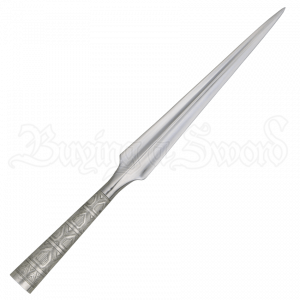
Throwing Spear Head
Lance
The Lances of Titan are NOT the classic, medieval, heavy lance seen in hundreds of movies as knights joust. Rather, they are more akin to the cavalry lances of earlier times, and again later in the 18th century. Averaging 10 to 12 feet in length, made of strong but light wood and an 8 to 10 inch point that is intended to skewer infantry or opposing horsemen or their horses.
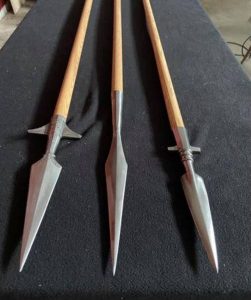
Spears
Swords
Though not as common on the battlefields as axes and spears, the sword has a special place in the hearts of every fighter. Virtually every culture and race has ‘traditional’ and preferred styles and warriors will argue the pluses and minuses of their preferred type. Most sages who have researched the matter agree that all the sword styles of Solista and Palador derive from one of three sources, or a blend of the types. The Dwarves, who to this day favor straight, double bladed swords leading to a blunt or obtuse angle at the tip. The Elves, whose leaf shaped swords widen towards the end, then taper down to a sharp stabbing point. Or the Zamoran Empire, which once ruled most of Palador and beyond, and introduced single edge, curved blades that still remain popular in the traditional ‘Falcon’ to this day.
Over time populations adopted, blended, stretched, sharpened, curved, recurved, straightened, shortened, widened, narrowed or lengthened these three general types to suit tastes, accommodate resources and kill local enemies the most efficiently.
DM Note: Longswords and ‘Bastard Swords’ (Hand and a Half Swords) Longswords ARE by definition a ‘hand and a half sword’. A significant part of their length IS the longer grip then that found on a one handed sword like a Broadsword or Short Sword. Consequently, the PHB entry for ‘Bastard Sword’ is being amended. Longsword damages are being upped, while the ‘Bastard Sword’ entry will now reference a heavier, hand and a half sword with a broader, heavier, blade. (Picture Conan’s sword in the movies!)
| Name | Cost | Weight GP |
Damage | |
| S – M | L | |||
| Dwarven (style) Broadsword | 10 | 35 | 2-8 | 2-12 |
| Dwarven (style) Longsword | 15 | 30 | 1-8 | 1-12 |
| Used Two Handed | — | — | 2-8 | 3-12 |
| Dwarven (style) Shortsword | 8 | 20 | 1-6 | 1-8 |
| Dwarven (style) Sword axe | 15 | 45 | 1-8+1 | 1-8+1 |
| Used Two Handed | — | — | 2-8+1 | 2-8+1 |
| Elvin (style) Longsword | 15 | 30 | 1-8 | 1-12 |
| Used Two Handed | — | — | 2-8 | 3-12 |
| Elvin (style) Shortsword | 8 | 20 | 1-6 | 1-8 |
| Gallennic Broadsword | 10 | 35 | 2-8 | 2-12 |
| Gallennic Hand & a Half Sword | 20 | 40 | 2-8 | 2-12 |
| Used Two Handed | — | — | 2-8+1 | 2-12+1 |
| Gallennic Shortsword | 8 | 20 | 1-6 | 1-8 |
| Gallennic Great Sword | 30 | 50 | 1-10 | 3-18 |
| Goblin ‘Tooth’ (scimitar) one handed | 15 | 30 | 1-8 | 1-10 |
| Goblin ‘Tooth’ (scimitar) Hand & a Half | 20 | 35 | 2-8 | 2-12 |
| Used Two Handed | — | — | 2-8+1 | 2-12+1 |
| Goblin ‘Tooth’ short (scimitar) | 8 | 20 | 1-6 | 1-8 |
| Halfling ‘Makka’ shortsword | 6 | 15 | 1-6 | 1-6 |
| Kiliga, (scimitar) one handed | 15 | 30 | 1-8 | 1-12 |
| Kiliga (scimitar) Hand & a Half | 20 | 35 | 2-8 | 2-12 |
| Used Two Handed | — | — | 2-8+1 | 2-12+1 |
| Solistan Broadsword | 10 | 35 | 2-8 | 2-12 |
| Solistan Longsword | 15 | 30 | 1-8 | 1-12 |
| Used Two Handed | — | — | 2-8 | 3-12 |
| Solistan Shortsword | 8 | 20 | 1-6 | 1-8 |
| Yatagan (scimitar) one handed | 15 | 30 | 1-8 | 1-12 |
| Zamoran Falcon (Broadsword) | 10 | 35 | 2-8+1 | 2-12+1 |
| Zamoran Lion (shortsword) | 8 | 20 | 1-6+1 | 1-8+1 |
(Sword prices include belt and scabbard)
Dwarven Swords:
Generally, Dwarven made and styled blades, regardless of length, are straight, double edged the full length, with a uniform width and thickness the entire length, before ending in an oblique point with sharp cutting edges. Deep fullers lighten the weight but still retain the strength of the blade. NOTE: The description and price above IS NOT for an actual, Dwarven MADE sword. It is for a Dwarven STYLE weapon made by human smiths.
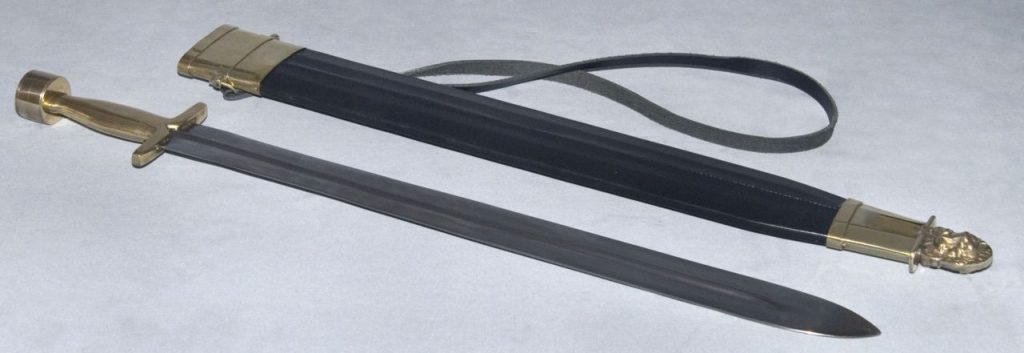
Dwarven Style Sword
Actual, Dwarven MADE weapons are automatically High Quality, never rust and hold a blade longer between sharpening. They cost 4 times listed value (if available.) A Dwarven made longsword is made for the human market. Dwarves rarely use longswords, favoring broadswords and shortswords instead. And their Broadswords tend to slightly shorter blades then a Broadsword of Dwarven design that is made for the human market.
Dwarven Sword Axe:
A straight, double edged, broadsword length blade with a cutting edge running the full length on both sides. Unlike a conventional broadsword the sword axe lacks a stabbing point. At the end it is flat but flares out to either side, almost tripling the width of the blade in the last 1/8 or so of its length. The edges of this flare are sharp, like an axe, and the weighted end allows axe like blows. (Anyone with proficiency in axe can use this weapon.) The sharpened full length blade allows for sweeping cuts like a sword. It can be used one handed or two handed. This is an old style weapon, dating from the Goblin Wars, that many Dwarves have replaced with stabbing bladed swords.
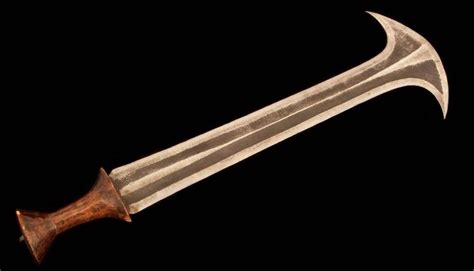
Dwarven Sword Ax
Elvin Swords
The Elves are known for the characteristic leaf shape of their swords and the aesthetically pleasing lines of their weapons . It is a form that has been copied by many human smiths and is popular through much of Solista. From a combat perspective, Elvin swords are ‘long’ or ‘short.’ NOTE: The description and price IS NOT for an actual, Elvin MADE sword. It is for an Elvin STYLE made by human smiths.
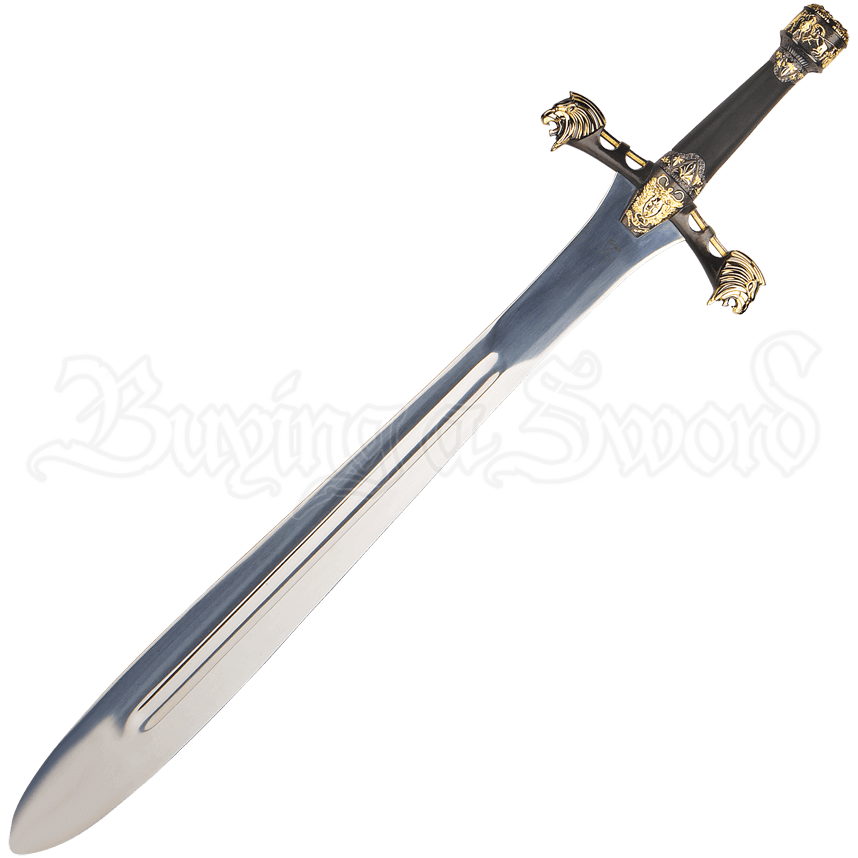
Elvin Long Sword
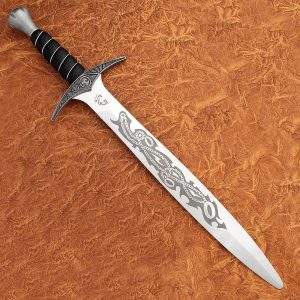
Elvin Short Sword
Gallennic Swords
The Barbarians have drawn much of their weapon and metal work design from the Dwarves. The overall designs are very similar to Dwarven swords. The Great Sword (two handed sword) is an exclusively Gallennic design.
Gallennic blade styles are found and made throughout southern ‘civilized’ Solista, being most common in the east.
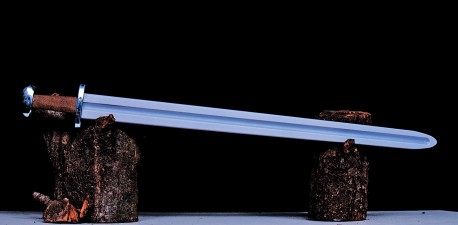
Gallennic Broadsword

Gallennic ‘Bastard’ Sword
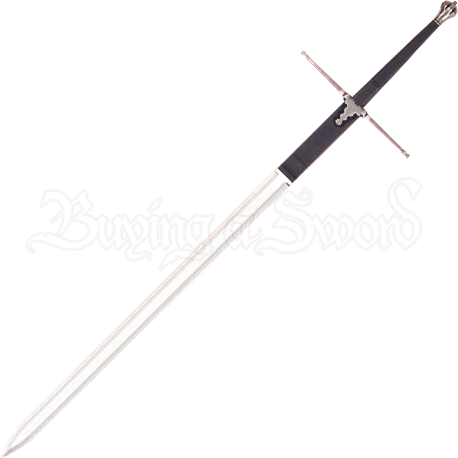
Gallennic Great Sword
Goblin ‘Tooth’
The Goblin tooth is a single, or sometimes double, edged weapon with a very deep curve and wickedly sharp point. The cutting edge is in the convex side and runs the entire length. The curve makes for a long cutting edge in draw attacks, but the over all ‘reach’ is shorter. Goblin ‘Teeth’ come in a variety of lengths from dagger sizes, short swords, and long sword. Popular with Goblins and Haeb-Goblins, they have also developed a following in some human populations. (Note: No self respecting Dwarf or Elf would ever use one!)

Goblin Tooth
Halfling ‘Makka’ Short Sword
A practical and largely peaceful people, the Halfling sword (always a short sword, and a small one at that!) is primarily an agricultural tool for cutting brush and splitting kindling. That it is also a handy weapon is a bonus. Every Halfling family has one of these. Called a ‘Makka’ it is a single-edged blade with a curved tip. The blade length is usually from 8” to 12” at most with the 4″ grip giving an average overall length of 12 to 16 inches. The overall shortness of the Makka reduces its effectiveness vs Large creatures.
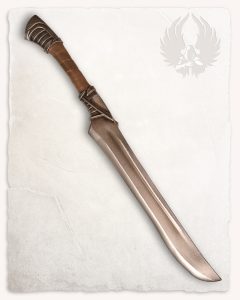
Makka
Solistan Swords
Solistan swords are noted for a steady taper from the widest part at the hilt down to a very sharp point. Solistan Long swords generally have 30” to 36” blade with an 9 to 12 inch grip and a simple ‘crucifix’ cross guard.. The extra length aids in mounted combat, being better able to reach targets on the ground, and the longer grip lets them be used one handed, with a shield, or two handed without.
Broadswords have 20 to 30 inch long blades that are wider, by anywhere from 1.5” to 3” at the hilts and with an 6 to 8 inch grip that is intended for one handed use. It is always used with a shield. Solistan Short swords usually have 14 to 20 inch blades with 6” to 8” grips.
The ‘Grah Pohl’ or ‘Greater Pohl’ is a longer, short sword length, version of the Pohl Dagger (see below.)
Solistan styles are very popular in the south central and south western areas, but they can be found in markets almost everywhere.
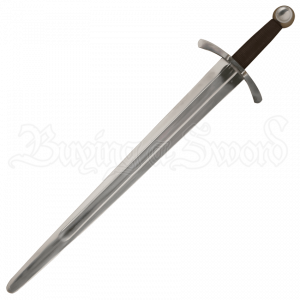
Solistan Broadsword

Solistan Long Sword
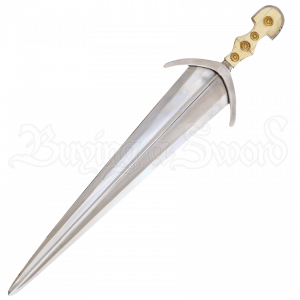
Grah Pohl or Greater Pohl
Zamoran Falcon and Lion
The Zamoran Falcon is a weapon with its origins in the Zamoran Empire at its peak, 4500+ years ago. It has a single-edged blade that pitches forward towards the point, the edge being concave near the hilt, but convex near the point. This shape distributes the weight in such a way that the falcon is capable of delivering a blow with the momentum of an axe, while maintaining the longer cutting edge of a sword and some facility to execute a thrust. The grip is typically hook-shaped, the end often stylized in the shape of a lion, horse or a bird, typically a Falcon (hence the name.) There is often a thin chain connecting the hooked butt with the hilt. The falcon’s blade is double-edged for about half its length. Typical blade length is 24 to 30 inches, though some are as short as 18 inches, with a grip of 6 inches. The Falcon head pommel and grip has become the ‘standard’ for the longer, broad sword versions with the Lion head pommel and grip associated with the short sword versions. The style is manufactured throughout Titan, having long ago traveled beyond Zamora. In Solista it is particularly common in the south, central lands along the coast.

Zamoran Falcon
Yatagan
The Yatagan, the primary sword of the Yttralan Nomads. It consists of a single-edged blade with a marked forward curve and a hilt formed of two grip plaques attached through the tang, the end of the hilt being shaped like large ears. The gap between the grips is covered by a metal strap, which is often decorated. The blade varies from 30 inches to 36 inches in length and is curved forward (like the Zamoran Falcon), sometimes reclining backwards again towards the very end. This blade form is often referred to as being ‘recurved’. It is roughly the equivalent of a Longsword for damage purposes and is always used one handed.

Yttral Yatagan
Kiliga
The origin of the Kiliga is, depending on who you ask, either from Trusk or Ilshar. Opinion will vary depending on where the individual is from. It is very common in both of those areas. Rudely known to many other people, as a ‘Truskan Tongue’ the Kiliga is a one-handed, single-edged sword with a slight curve on the blade towards the point on the end and most are affixed with a quillioned cross guard for the hilt in the manner of contemporary long swords. In general it conforms to a scimitar in shape and there are one handed versions and ‘hand & a half’ versions.
Widely and commonly used across Ilshar and Trusk, it is also common throughout northern coastal Palador. In Solista it can be found, along side Solistan styled blades, in the west coastal areas, especially near and in, Tarpia.
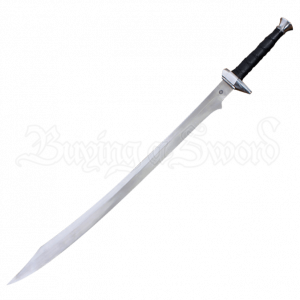
Kiliga
Daggers and Knives
Although hardly a battlefield weapon, except in moments of extremis, the dagger or knife is the only weapon more common then the axe. While every peasant family has an axe, every peasant, their spouse and children ALL have a knife or a dagger! Rich or poor, virtually everyone has one. Quality may vary, but you can bleed out just as easily on a dull, rusty, beggar’s blade as a gilded and bejeweled nobleman’s dagger.
Note: Daggers are double edged. Knives are single edged.
| Name | Cost GP |
Weight GP |
Damage | |
| S – M | L | |||
| Dagger, small 4″- 6″ blade | 1 | 7 | 1-3 | 1 |
| Thrown | — | — | 1-3 | 1 |
| Dagger, medium 6″ – 8″ blade | 2 | 10 | 1-4 | 1-3 |
| Thrown | — | — | 1-4 | 1-3 |
| Dagger, large 8″- 10″ blade | 3 | 15 | 1-4+1 | 1-3+1 |
| Thrown | — | — | 1-4+1 | 1-3+1 |
| Knife, sheath 5″- 7″ blade | 2 | 10 | 1-4 | 1-3 |
| Thrown | — | — | 1-4 | 1-3 |
| Knife, sheath 7″- 10″ blade | 3 | 15 | 1-4+1 | 1-3+1 |
| Thrown | — | — | 1-4+1 | 1-3+1 |
| Knife, folding 3″-5″ blade | 10sp | 5 | 1-2 | 1 |
| Thrown -1 to hit | — | — | 1-2 | 1 |
| Knife, folding 5″- 7″ blade | 1 | 7 | 1-3 | 1-3 |
| Thrown -1 to hit | — | — | 1-3 | 1-3 |
| Pohl, dagger 10″ blade | 5 | 20 | 1-4+2 | 1-4+2 |
| Thrown -3 to hit | — | — | 1-4 | 1-4 |
| Throwing Dagger (knife) 6″-8″ | 5 (pair) | 15 (pair) | 1-4-1 | 1-3-1 |
| Thrown +1 to hit | — | — | 1-4 | 1-3 |
| Throwing Dagger (knife) 8″-10″ | 7 (pair) | 25 (pair) | 1-4 | 1-3 |
| Thrown +1 to hit | — | — | 1-4+1 | 1-3+1 |
(Price Includes scabbard)
| Name | Fire Rate | Range | ||
| Short | Medium | Long | ||
| Dagger, small 4″- 6″ blade | 2 | 1.5 | 2.5 | 3 |
| Dagger, medium 6″ – 8″ blade | 2 | 1 | 2 | 3 |
| Dagger, large 8″- 10″ blade | 2 | 1 | 2 | 3 |
| Knife, sheath 5″- 7″ blade | 2 | 1 | 2 | 3 |
| Knife, sheath 7″- 10″ blade | 2 | 1 | 2 | 3 |
| Knife, folding 3″-5″ blade | 2* | 1 | 1.5 | 2 |
| Knife, folding 5″- 7″ blade | 2* | 1 | 1.5 | 2 |
| Pohl, dagger | 2 | .5 | 1 | 1.5 |
| Throwing Dagger (knife) 6″-8″ | 2 | 2.5 | 3.5 | 4.5 |
| Throwing Dagger (knife) large 8″-10″ | 2 | 2 | 3 | 4 |
* If opened and ready. Otherwise RoF = 1
Throwing daggers (knives)
Throwing daggers and knives are designed and balanced for accurate throwing. As such they have better range and are +1 to hit. They are sharply pointed but have no cutting blade. They cannot be used to cut anything! Sharpening an edge will throw off the balance and lose the +1 to hit bonus and extra range. They are not well suited for melee and hand to hand combat, being -1 damage when stabbing. Note: Throwing daggers(knives) are sold in pairs. The price reflects 2 throwing daggers.
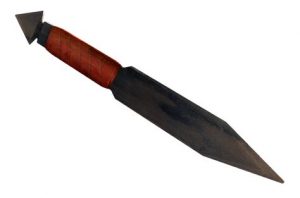
Large Throwing Dagger
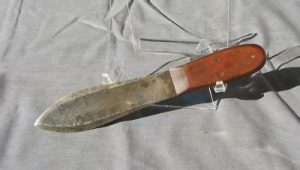
Small Throwing Dagger
Folding Knife (pocket knife)
Light weight blade intended for utilitarian use rather then combat, but can be used if that is all that is available. If used in melee the knife breaks on any roll of 1 or 2 on a D6. Roll after every successful hit. If Thrown the knife breaks on a roll of 1 or 2 on a D6 IF the throw misses. (Hits some hard object, etc.) Wood, bone or antler body.
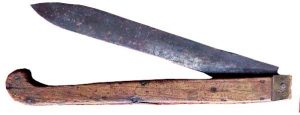
Folding knife
The ‘Pohl’
The Pohl is a type of dagger that first made its appearance in the towns of the Pohl River Valley in south, central Solista. The large blade is very wide at the hilt, tapering to a sharp point, making for an almost triangular blade. Note: Pohl Daggers do not throw well. -3 to hit when thrown. It is a very good close combat dagger and is popular with merchants and Magic Users.
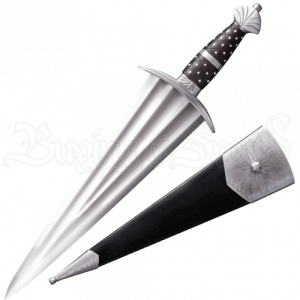
Pohl Dagger
Maces & Morning stars
There are a variety of Maces and their cousins, clubs, cudgels and morning stars, in use throughout Titan. Clubs and cudgels are found virtually everywhere and in varying lengths. Constructed of wood and usually set with nails, studs, bits of rock and such. They are, along with axes and improvised weapons, the principal peasant weapon.
Most maces are set with flanges, points, knobs, blades, spikes and textures designed to increase the damage inflicted by the weapon. The traditional smooth or rounded head mace is rare in iron or steel. Most such weapons have stone heads. Morning stars are a spiked variety of mace that is popular with many Goblins.
Kostrin Clerics, in an effort to honor their Founder’s teachings, long ago adopted a style of Bar Mace as the weapon of their clerics. Bar maces are, reputedly, an ancient Dwarven weapon that was designed to be swiftly mass produced to arm poorly trained humans in the Goblin Wars of long ago.
A Footman’s or Infantry Mace is a longer mace that can be used one or two handed. A horseman’s or Cavalry Mace is a shorter, one handed weapon. Note: Many foot soldiers carry cavalry sized maces so as to be able to better employ a shield.
| Name | Cost GP |
Weight GP |
Damage | |
| S – M | L | |||
| Kostrin Mace (Bar Mace) | 6 | 40 | 1-6 | 1-4 |
| Two handed | — | — | 1-6+1 | 1-4+1 |
| Footman’s Mace | 8 | 100 | 1-6+1 | 1-6 |
| Two handed | — | — | 1-6+2 | 1-6+1 |
| Horseman’s Mace | 4 | 50 | 1-6+1 | 1-4+1 |
| ‘Goblin Star’ (Morningstar) | 3 | 45 | 1-6+1 | 1-6 |
| Footman’s Morningstar | 5 | 110 | 2-8 | 1-6+1 |
| Two handed | — | — | 2-8+1 | 1-6+2 |
| Horseman’s Morningstar | 4 | 55 | 1-6+1 | 1-6 |
| Spiked Cudgel | 3 | 35 | 1-6 | 1-4 |
| Two handed | — | — | 1-6+1 | 1-4+1 |
| Club, Heavy | — | 30 | 1-6 | 1-3 |
| Two handed | — | — | 1-6+1 | 1-4 |
| Club, light one handed | — | 10 | 1-4 | 1-2 |
| Thrown -1 to hit | — | — | 1-2 | 1 |
Kostrin Mace
There is a long standing restriction in the Kostrin Churches against the use of bladed, edged and pointed weapons. Teachings say that this prohibition is the result of a command by Kostris to ‘Not Shed the Blood of Thy Neighbor…’ Traditional battle maces often have flanges around the heads, so early Church Leaders adopted a version of an old and simple Dwarven weapon, the Bar Mace. This can be used one handed or two.
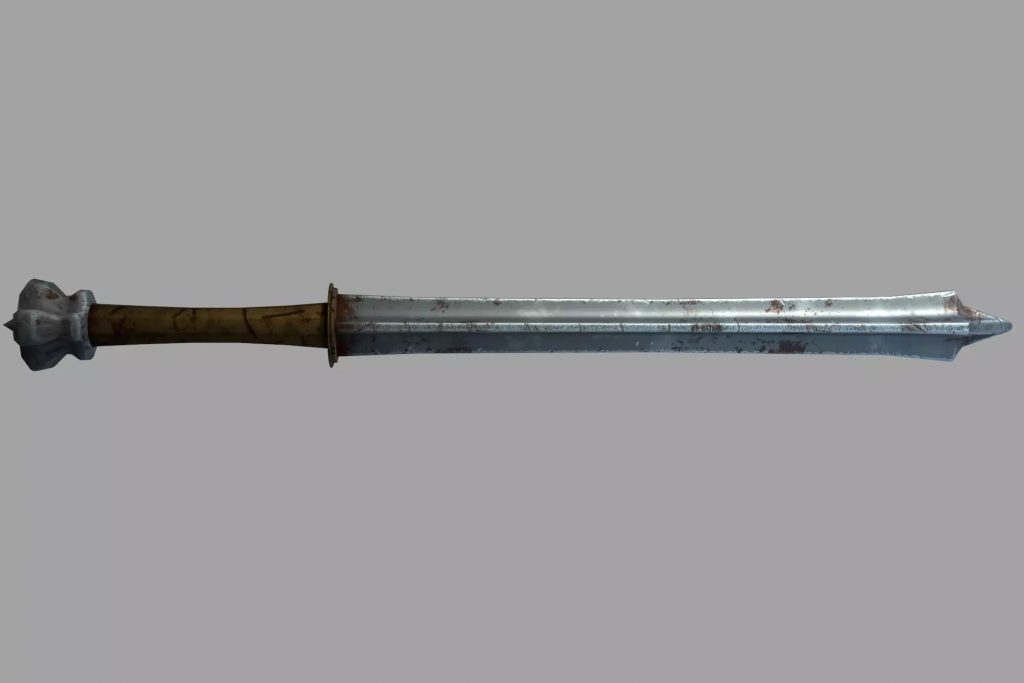
Kostrin Mace
Holy Water Sprinkler
This variety of bar-mace has a hollow head at the end, which has a hinged cap. When filled with liquid, the fluid will run through small holes and down ridges of the mace. The mace is designed for clerics sent to fight the Undead. A single glass vial of Holy Water can be poured into the head, coating the mace and doing additional damage.
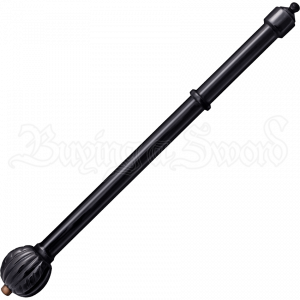
Holy Water Sprinkler
Footman’s Mace
This weapon can be used one handed or two handed. Using it two handed does extra damage, but the wielder must forgo a shield.
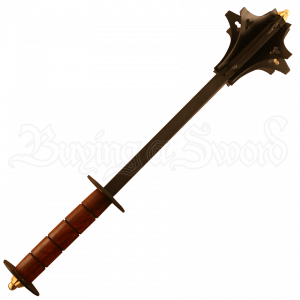
Foot Man’s Mace
Horseman’s Mace
This is a one handed weapon for use by cavalry. It is also often used by foot soldiers who wish to use a shield.
Goblin ‘Star’ (Morningstar)
A name given to short wooden hafted, one handed weapons that mount a spiked metal ball at the end. Inexpensive and easily made, they were, and are, widely used as a primary melee weapon by many Goblins and a secondary by many of the Haeb. Variations are common throughout Solista, but the term ‘Goblin Star’ applies specifically to the wood hafted, simple versions.

‘Goblin Star’
Footman’s Morningstar
This weapon can be used one handed or two handed. Using it two handed does extra damage, but the wielder must forgo a shield.
Horseman’s Morningstar
This is a one handed weapon. It is often used by foot soldiers who wish to use a shield.
Cudgels
Easily and cheaply made in any village smithy or wood shop or even fabricated at home. Popular with brigands and thieves due to their intimidating appearance and ease of acquisition.
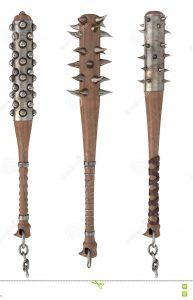
Spiked Cudgels
Clubs
The weapon of last resort for the poor and destitute. There is no price listed since it is presumed that the owner of a club ‘harvested’ it themselves.
Heavy clubs vary in length from 2′ to 4′ and can be used one or two handed.
Light clubs, are less then two feet in length and are used one handed only. They can be thrown, and are used by some Kostrin clerics.
Note: Anyone with a proficiency in Mace, Morningstar, Axe, Hammer or sword can pick up and employ a club with no penalties.
Hammers & Picks
These are less common in terms of general use, then axes or maces.
Mauls, essentially reinforced sledge hammers are not common on battlefields, but the civilian version (sledge hammer) is a handy ‘go to’ among miners and workers.
Light weight (2lb) hammers are common tools on farms and in shops, making them a handy weapon.
War Hammers originated with Dwarven miners, but has been adopted and adapted by others.
| Name | Cost | Weight | Damage | |
| S – M | L | |||
| Hammer/Maul | 7 | 100 | 1-8 | 1-6 |
| Two handed | — | — | 1-8+1 | 1-6+1 |
| Hammer | 1 | 20 | 2-5 | 1-4 |
| Thrown -1 to hit | — | — | 2-5 | 1-4 |
| War Hammer/Pick hammer Footman’s One Handed | 8 | 80 | 1-6 | 1-4 |
| Two handed hammer | — | — | 1-6+1 | 1-4+1 |
| One handed pick | — | — | 1-6+1 | 2-8 |
| Two handed pick | — | — | 1-6+2 | 2-8+1 |
| War Hammer/Pick hammer Horseman One handed | 5 | 40 | 1-6 | 1-4 |
| One handed pick | — | — | 1-4+1 | 1-4 |
Maul
Sometimes used by Kostrin Clerics instead of the Bar Mace. This is a Sledge Hammer intended to break enemies rather then rocks. It can be used one handed or two handed.
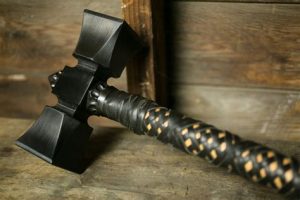
Maul
Hammer
These light hammers have roughly the same heft and balance as a common hand axe or hatchet. They can be used as a tool or as a one handed weapon. They can also be thrown, though at -1 to hit. It is one of the few missile weapons available to Kostrin Clerics.
War Hammer
A combination weapon with a blunt hammer face paired with a spike or ‘pick’. Popular with some Dwarves it is not widely used outside of central Solista.
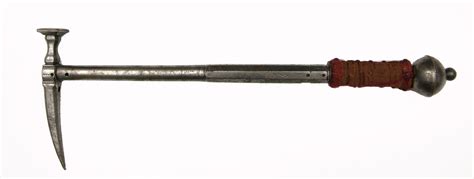
War Hammer
Flails
Battle grade flails evolved from the agricultural tools intended to separate grain from the stalk. It is one of the few weapons that appears to have an entirely ‘human’ origin.
| Name | Cost | Weight | Damage | |
| S – M | L | |||
| Chain Flail, footman | 6 | 50 | 1-8 | 1-4 |
| Two handed | — | — | 1-8+1 | 1-6 |
| Chain Flail, horseman | 4 | 20 | 1-6 | 1-4 |
| Battle Flail, single footman | 8 | 60 | 2-8 | 1-6 |
| Two handed | — | — | 2-8+1 | 2-7+1 |
| Battle Flail, single horseman | 6 | 30 | 1-6+1 | 1-6 |
| Battle Flail, double footman | 12 | 70 | 2-8+2 | 1-8 |
| Two handed | — | — | 2-8+3 | 2-8+1 |
| Battle Flail, double horseman | 10 | 40 | 2-8+1 | 1-8 |
Chain Flail
Unadorned with spikes or other blood letting accouterments, the Chain Flail is used by some Kostrin Clerics, especially the Followers of Darian who see it as a symbol of simplicity and humanity. Chain Flails are always double chain. Footman and Horseman versions are available.
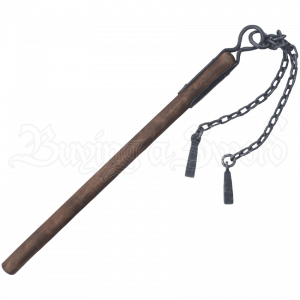
Chain Flail
Battle Flail
Unlike the Chain Flail, these are designed to draw blood from the target.
Single Chain and Double Chain Flails are used. Generally, the single chain versions use a larger spiked ball or weight then the double chain flail. But the weight of the two heads together on the double chain flail roughly equals the single head.
There is no standard as to how many, or long, the spikes and blades attached to the chains are. Footman and Horseman versio
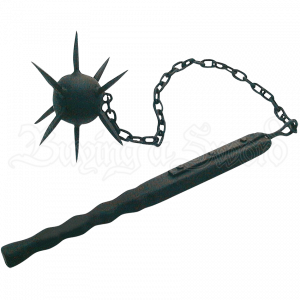
Single Battle Flail
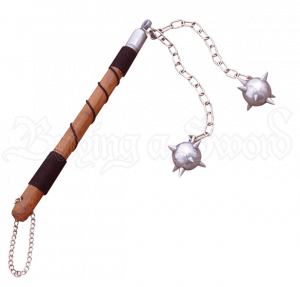
Double Battle Flail
Staff, Quarter
A weapon, and walking aid, used widely throughout Titan.
As a ‘bloodless’ weapon it can be used by Kostrin clerics. It can be employed one handed or two. Note: Damage listed in the PHB is for using the staff two handed. Using it one handed it is treated as a club.
| Name | Cost | Weight GP |
Damage | |
| S – M | L | |||
| Staff | — | 50 | 1-6 | 1-3 |
| Two Handed | — | — | 1-6 | 1-6 |
Sling
Another weapon common amongst the poor.
| Name | Cost | Weight GP |
Damage | |
| S – M | L | |||
| Sling | — | — | — | — |
| Sling Stone | — | 1 each stone | 1-4 | 1-4 |
| Sling Bullet | 10sp per 12 15sp per 20 |
2 each bullet 24 for 12 40 for 20 |
2-5 | 2-7 |
| Name | Fire Rate | Range | ||
| Short | Medium | Long | ||
| Sling Stone | 1 | 5 | 10 | 20 |
| Sling Bullet | 1 | 4 | 8 | 16 |
Other Weapons
There are a variety of other common weapons used throughout Titan, some mundane and ubiquitous, others exotic and restricted geographically or culturally.